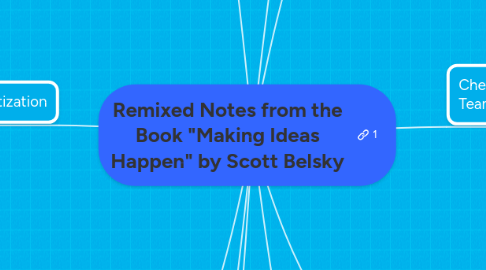
1. The Action Method
1.1. 3 elements
1.1.1. Action Steps
1.1.1.1. move projects forward
1.1.1.2. should always be separate from email
1.1.1.3. Give them their own sacred space
1.1.1.4. Types
1.1.1.4.1. "Ensure"
1.1.1.4.2. "Await"
1.1.1.4.3. Regular
1.1.1.5. each team member must own their action steps
1.1.1.5.1. ownership = more likely to be executed
1.1.1.6. True delegation = fully "accepted" by the other
1.1.1.6.1. 1) creates true accountability
1.1.1.6.2. 2) It's a "handshake"
1.1.1.7. Accept Action Steps only if:
1.1.1.7.1. 1) They're clear
1.1.1.7.2. 2) They're doable/executable
1.1.1.7.3. if an Action Step is ambiguous or unclear, reject, discuss, and seek clarification
1.1.2. References
1.1.2.1. Taking extensive notes aren't worth the effort
1.1.3. Backburners
1.2. Audit current project through the Action Method Lens
1.3. Reduces project management to its most basic elements
1.4. A relentless bias towards action pushes ideas forward
1.5. Foster an action-oriented culture
1.6. Have a common language (aka system) w/ colleagues re: action steps
1.7. Have an inbox transit terminal that's checked at preferred intervals
2. Prioritization
2.1. Projects should be based on:
2.1.1. 1) Economic Value
2.1.2. 2) Strategic Value
2.2. 3 Elements of Prioritization
2.2.1. 1) Helpful pressure from others
2.2.2. 2) Self-discipline
2.2.3. 3) Sound judgment
2.3. Make 2 lists:
2.3.1. 1) Urgent
2.3.2. 2) Important
2.4. Use an Energy Line
2.4.1. 1) Help budget time
2.4.2. 2) Visualize what projects need most attention
2.5. Don't dwell
2.5.1. 1) Decide whether something is beyond your influence
2.5.2. 2) Make the decision and move on
2.6. Choose 5 projects that matter most
2.7. Daily focus area
2.8. Don't hoard urgent items
2.9. Create Responsibility Grid
2.9.1. Allows tasks to get delegated and properly agreed-on
2.10. encouragement
2.11. gentle reminders
2.12. Darwinian/Collective Prioritzation (aka "nagging")
2.12.1. secret to execution
3. Execution
3.1. Execution = perspiration
3.2. Momentum = key to execution
3.3. Act without conviction, even if reckless
4. Communal Forces
4.1. Share ideas on how teams can work more effectively and efficiently; you discover how to:
4.1.1. a) maximize time
4.1.2. b) maximize energy
4.1.3. c) maximize money
4.2. Sharing ideas
4.2.1. a) helps refinement
4.2.2. b) increases odds of gaining momentum
4.3. Don't become burdened by consensus
4.3.1. Don't strive for complete consensus; it's comfortable, but hardly remarkable
4.3.2. 1) Find solutions on both ends of the spectrum
4.3.3. 2) Seek outliers
4.3.4. 3) Strike compromises based on truly distinguishing and sacred solutions, and make the case for why they're crucial
4.4. Encourage START/STOP/CONTINUE
4.4.1. In meetings
4.4.2. In discussions
4.5. best channeled in circles
4.6. Commit fully so others can commit their resources to you, too
4.7. Systems of accountability help
5. Rules of Idea Generation and Human Nature
5.1. 1) A tired brain doesn't work well
5.2. 2) Idea generation happens on its own terms
5.3. 3) When forced to execute beyond your capacity, you begin to hate what you're doing
5.4. Measure in goal out-put, rather than sit-put
5.5. People thrive when people's individual judgment and autonomy are respected
6. Use design-centric systems
6.1. Aesthetics matter
6.2. visual appeal = more likely to be executed
7. Meetings
7.1. 1) Avoid automatic meetings that:
7.1.1. a) don't have an agenda
7.1.2. b) don't have an actionable agenda
7.2. 2) End with a review of Actions captured
7.2.1. a) do round table review of captured Action Steps
7.2.2. b) Should take less than 30 secs
7.2.3. c) breeds accountability
7.3. 3) Call out non-actionable meetings
7.3.1. a) It's everyone's responsibility
7.3.2. b) They're pointless and are expensive in terms of time and energy
7.4. 4) Standing meetings may work
7.5. 5) Avoid meetings because of personal insecurity
7.5.1. a) great leaders candidly ask why a meeting is being called
7.5.2. b) Leaders protect time, energy, and resources
7.6. 6) Don't stick to meetings with round numbers
7.7. 7) Meetings must have both an objective and actionable outcome
8. Chemistry of a high-performing Creative Team
8.1. Look beyond tech skills and develop a chemistry that will transform ideas into remarkable accomplishments
8.2. Team members should have:
8.2.1. a) General breadth of skills that supports collaboration
8.2.2. b) Good chemistry
8.2.3. c) deep expertise in a relevant area
